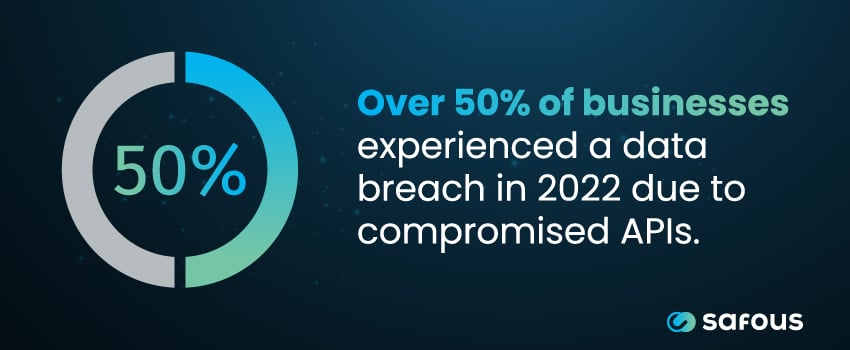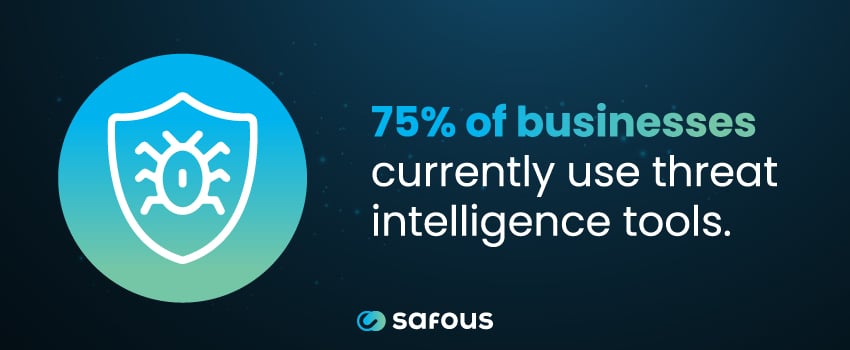Application programming interfaces (APIs) play a crucial role in business growth and development as the backbone of modern web applications. They allow different systems to interact and share data, fostering innovation by enabling businesses to leverage existing services instead of building everything from scratch.
Today's web apps are made up of between 26 to 50 public-facing APIs.1 But while APIs play a pivotal role in customer engagement and service delivery, they're also a prime target for cyberattacks. Over 50% of organizations experienced a breach due to compromised APIs in 2022,2 underscoring the urgency to fortify web application defenses.
Web application and API protection (WAAP) is becoming a critical tool in the modern developer's arsenal by offering robust security measures tailored to modern web interfaces. In this blog, we'll explore best practices for API security and the benefits of leveraging WAAP for optimal protection.
What Is API Security?
API security refers to the practices and protocols that protect a company's APIs from misuse and other potential security threats. API gateways facilitate data exchange, making them essential for creating and integrating new software applications. Unfortunately, as their usage increases, so does the risk of cyberattacks such as unauthorized access, data loss, or breaches. And these attacks are particularly damaging, as one in ten web application vulnerabilities are considered high or critical risk.3
Some key aspects of API security include:
Authentication
REST API security solutions use a JWT token, API key, OAuth, or other measures to identify and authorize traffic requests, preventing abuse from unknown or unauthorized users.
Access Control
Access control refers to applying permission policies that limit which users and systems can access the API client and what actions they can perform.
Data Encryption
API security tools encrypt API requests using encryption mechanisms like TLS, which is used by 81% of all web traffic.4 Encryption helps prevent snooping and eavesdropping on communications sent through the application programming interface.
Input Validation
API security solutions sanitize and validate all parameters in API traffic to prevent code injection, data leakage, or logical attacks.
Rate Limiting
Rate limiting occurs when API security solutions throttle the number of API requests allowed per timeframe to prevent DDoS and brute force attacks.
Monitoring
API security tools regularly log API activity and leverage analytics to detect suspicious behaviors that might indicate possible attacks.
Documentation
By providing proper developer documentation, API security helps IT teams ensure they're not revealing unnecessary API implementation details that could help potential attackers.

What Are Common Web Application Security Risks?
Web applications and the APIs that power them are prime targets for cybercriminals. Here are some common API security risks traditional web applications face:
Zero-Day Vulnerabilities
Zero-day vulnerabilities are software flaws unknown to an application's developers, so they don't have an available fix. These vulnerabilities are often used as an entry point for larger, more complex attacks, making them a serious concern for web application security.
SQL Injection
SQL injection attacks occur when an attacker manipulates an application's input data to gain access to sensitive data or corrupt back-end databases via the web app interface.
Credential Stuffing
Credential stuffing is when attackers use automated scripts to test username and password combinations obtained from previous breaches, banking on the fact that many users reuse passwords across multiple platforms. If successful, attackers can access accounts to steal data or perform other malicious activities.
Cross-Site Scripting (XSS)
In XSS attacks, hackers inject malicious scripts into trusted websites. When users interact with these compromised websites, the malicious script executes to steal data or compromise their sessions.
Cross-Site Request Forgery (CSRF)
CSRF attacks trick users into performing actions on a web app without their knowledge, exploiting their logged-in state.
Shadow APIs
Shadow API usage increased by 900% in 2022.5 Shadow APIs are unofficial or undocumented APIs in web apps that developers often create for convenience or one-off use. They typically aren't as closely monitored or secured as official APIs, so they're often overlooked during security audits and vulnerable to exploitation.
Security Misconfigurations
Poorly configured security settings in API implementations and web apps leave the system vulnerable, which can potentially expose sensitive data or grant unauthorized access to attackers.
Popular Web Application Security Strategies
Web app and API security are constantly evolving practices. However, there are some essential web application security strategies that API developers rely on to combat advanced security threats and limit access to sensitive data, including:
Web Application Firewall
Web application firewalls (WAFs) work at the application layer, acting as a shield between the web application and the internet. They analyze HTTP requests to and from web applications to provide real-time protection against vulnerabilities.
DDoS Mitigation
DDoS mitigation services use specialized filtration and high bandwidth capacity to mitigate Distributed Denial-of-Service (DDoS) attacks targeting web apps. These services aim to ensure the availability and uninterrupted service of an application during an ongoing attack, minimizing downtime and loss.
Bot Management
Bot management uses AI and machine learning to distinguish between legitimate web traffic and malicious bots, such as those used for DDoS attacks, web scraping, and brute force attacks. Bot management tools use techniques like machine learning and other advanced detection methods to identify and block malicious bot activities, ensuring a secure online environment for users and protecting sensitive information from potential threats.
Web Application and API Protection (WAAP)
WAAP solutions serve as comprehensive security controls to defend web apps and API endpoints against a wide range of threats. They fuse traditional security practices with advanced techniques to provide holistic protection against common vulnerabilities as well as more sophisticated threats, such as bot attacks and zero-day vulnerabilities.

Why Are WAAP Tools Important for API Security?
WAAP solutions are integral for API security because they provide comprehensive security features designed to counter the unique threats and vulnerabilities APIs face. WAAP solutions monitor traffic, identify suspicious behavior, and quickly react to security risks to keep web apps and API endpoints secure. They also adapt to the ever-evolving API threat landscape, continuously learning from new threat patterns and adjusting their protection mechanisms to ensure your security posture remains strong even as new threats emerge.
By providing robust and adaptive protection, WAAP solutions are indispensable for maintaining the security of API gateways. They not only help to prevent data breaches and ensure the smooth functioning of APIs but also uphold the trust of users and support compliance with regulatory requirements.
What API Security Best Practices Should Developers Follow?
When it comes to API security, developers shoulder a hefty responsibility. They need to implement practices that enhance the integrity of APIs to prevent unauthorized access and breaches. Key API security best practices developers should follow include:
Using Strong Authentication and Authorization
Authentication and authorization form the first line of defense in REST API security, acting as the gatekeepers to sensitive data and functionalities. Secure authentication methods verify the identities of users to ensure that only trusted entities can gain access to the API gateway. It mitigates the risk of impersonation attacks, where attackers pose as authenticated users to gain unauthorized access.
Authorization controls what an authenticated user can do, adding another layer of security. Even if a user is authenticated, they may not have the necessary permissions to access sensitive data or perform specific actions. This principle of least privilege, which refers to giving users only the permissions they need to do their jobs, helps to limit damage in the event of an account compromise. Together, API authentication and authorization can help make sure only legitimate users can interact with the web app, safeguarding the integrity of the system and the privacy of its confidential data.
Requiring Input Validation
Input validation checks all user input data to ensure that only approved data types, lengths, or values can be entered. By validating data, developers can make sure only valid, safe data is accepted by the API.
Another important aspect of input validation is that it can safeguard against unwanted side effects caused by processing invalid data. For example, by validating that an incoming numeric value doesn't exceed the maximum value an integer can hold, the API can prevent an integer overflow.
Encrypting Data
Developers should encrypt data in transit using secure protocols, so even if an attacker manages to intercept the data during transmission, they can't read it. Encoded data can only be decrypted using a unique key, so encryption reduces the risk of your sensitive data being exploited if it's intercepted.
Sensitive data at rest should also be encrypted to ensure unauthorized users can't access sensitive information if they gain access to the storage system.
Implementing Rate Limiting
Rate limiting defends against brute force attacks and DDoS attacks by restricting the requests a user can make within a specific time frame. By reducing these types of attacks, these restrictions help secure the application's resources and ensure they remain available for all users.
Regularly Updating and Patching APIs
New vulnerabilities can emerge over time due to various factors, such as changes in related software, exposure to new threats, and evolving attack tactics of cybercriminals. Updates often include enhancements to the API's features or improvements to its existing security measures, helping to better protect your digital assets. Patches, on the other hand, specifically address every known API vulnerability to prevent exploitation by threat actors.
Failing to promptly apply updates and patches can leave your system exposed to potential attacks, leading to data breaches, loss of functionality, and compromised system integrity.
Using Web Application Firewalls
Implementing a WAF can provide an additional layer of security for your REST APIs. WAFs provide a protective barrier between the application and the internet by inspecting and monitoring HTTP requests in real-time. Because WAFs blog malicious requests at the edge network, they prevent threats from ever reaching the API servers, thereby reducing the risk of an attack compromising the API's functionality.
WAFs can also filter out traffic based on IP addresses, HTTP headers, and method strings, which allows developers to block requests from known malicious sources or suspicious interactions that don't conform to the API's expected behavior. This selective filtering feature increases their efficiency in spotting potential threats, further bolstering API security.
Logging and Monitoring API Traffic
Proper logging and monitoring of API gateway activities helps identify unusual activity or anomalies that could indicate a security threat, such as repeated failed login attempts or unusually high data transfer rates, allowing for quick response and mitigation. It also provides a detailed record of all interactions with the application programming interface, which can be invaluable if a security breach occurs.
By analyzing logs, investigators can trace back the actions of an attacker, understand their methods, and identify any compromised data. Monitoring also helps developers check that the system is functioning as expected and address any anomalies quickly.
Other Important Considerations for Web API Security
Web API security is a broad topic, so you might consider implementing a few additional measures beyond the basic practices we've already discussed. The following measures can help boost your API security posture, as well as enhance the overall efficiency and reliability of your application.
Embracing Heterogeneous Infrastructure
Growing businesses often have diverse IT infrastructures that include a combination of on-prem, cloud-based, and hybrid systems. This diversity can bring challenges in terms of REST API security, as different systems may have specific security requirements and vulnerabilities. Your developers will have to accommodate this heterogeneous infrastructure by ensuring their API security strategies protect all systems, regardless of type or location.
Implementing Infrastructure-Agnostic Web Security
The varied nature of modern IT infrastructures renders a one-size-fits-all approach to web security ineffective. Instead, an infrastructure-agnostic web security approach can offer your business more robust protection. This approach isn't limited to any specific type of infrastructure and can be applied across different systems, helping ensure consistent security regardless of where your data is stored or how your employees access it.

Considering Threat Intelligence
Integrating threat intelligence into your API security strategy can provide crucial insights into the latest cyber threats. Around 75% of businesses currently use threat intelligence on an ongoing basis,6 which involves the collection and analysis of data about emerging threats and vulnerabilities to help your security teams anticipate attacks and take proactive measures to secure the API gateway.
Including Security in the API Design Phase
Your team should prioritize security from the beginning of the API development process. This approach, known as security by design, can help identify security issues early on, making them easier to address and reducing the risk of future breaches.
Enhance Your API Security With Safous WAAP
As tempting as it may be to implement a few basic security measures and call it a day, API security isn't a one-and-done task. Chief Information Security Officers must continuously adapt and improve their API security strategies to protect against sophisticated new threats. By adhering to the best practices shared above, you can protect your web applications – and your customers' sensitive information – from threats.
We designed Safous WAAP to secure APIs the easy way. As the first API protection that uses zero-trust access technology, Safous WAAP delivers strong API authentication, WAF functionality, and DDoS countermeasures for less than half the price of a full WAAP solution from other companies.
Unlike basic WAAP solutions, Safous WAAP hides authenticated API endpoints from the public internet to provide complete protection against zero-day attacks. By making API endpoints invisible to attackers, our security platform can help you:
- Eliminate Vulnerabilities - Safous WAAP eliminates API gateway vulnerabilities that can result in significant damage to your business, such as data leakage and unauthorized application access.
- Reduce Security Costs - Our authentication-based, zero-trust access approach gives organizations complete API endpoint protection for less.
- Deploy Advanced Protections - Safous WAAP lets you add DDoS, access control, and WAF functionality to every API endpoint using our zero-trust access technology.
- Simplified API Management - Our intuitive, user-friendly admin portal makes it easy to install, configure, and manage your API security from a single interface.
Ready to take the first step towards proactive, robust API security? Request a demo today to Safous WAAP in action.
Sources:
- https://www.paloaltonetworks.com/resources/research/api-security-statistics-report
- https://venturebeat.com/security/data-breaches-api
- https://www.comparitech.com/blog/information-security/cybersecurity-vulnerability-statistics
- https://www.businesswire.com/news/home/20220526005152/en/Gigamon-Releases-%E2%80%9C2022-TLS-Trends-Research%E2%80%9D-Based-on-1.3-Trillion-Network-Flows
- https://www.businesswire.com/news/home/20230516005175/en/Shadow-API-Usage-Surges-900-Revealing-Alarming-Lack-of-API-Visibility-Among-Enterprises
- https://www.fortunebusinessinsights.com/threat-intelligence-market-102984
Receive the latest news, events, webcasts and special offers!
Share this
You May Also Like
These Related Stories

How ZTA and WAAP Solutions Work Together To Secure Your Business

WAAP to the Rescue: Why Is It Better Than WAF?




